Beth Kanell's Blog, page 22
February 8, 2013
History Mysteries: Beverly, Mass.
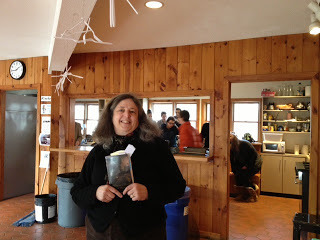 Me, happily preparing for another session at The Waring SchoolRecently I visited The Waring School in Beverly, Mass., where students filled me in on Waring's two basic commandments ("Don't be mean. Don't be stupid.") and what it's like to take part in this intense and people-focused 15-student college preparatory school. I learned a lot -- and enjoyed sharing writing skills, revision systems, and the three books I've brought forth so far that are historical fiction, hinged where our view of "what happened then" is being changed by our culture and our ability to study the past. These books are also mysteries, with young adult protagonists fighting for truth (The Darkness Under the Water; The Secret Room; Cold Midnight).
Me, happily preparing for another session at The Waring SchoolRecently I visited The Waring School in Beverly, Mass., where students filled me in on Waring's two basic commandments ("Don't be mean. Don't be stupid.") and what it's like to take part in this intense and people-focused 15-student college preparatory school. I learned a lot -- and enjoyed sharing writing skills, revision systems, and the three books I've brought forth so far that are historical fiction, hinged where our view of "what happened then" is being changed by our culture and our ability to study the past. These books are also mysteries, with young adult protagonists fighting for truth (The Darkness Under the Water; The Secret Room; Cold Midnight).Here are some possibilities for launching "history mysteries" set in the rich history of Beverly, Mass.; if you teach a group where your local version of this could be of use, or are a student who'd like a set of these for your classroom, e-mail me (BethKanellAuthor at gmail dot com) and I'll be glad to work up a set for your town!
BEVERLY, MASS., HISTORY MYSTERIES STARTING POINTS
1. 1626, Richard Conant and his "company of fishermen" arrive from Cape Ann, in Naumkeag territory: (a) Who were these fishermen? What secrets did they leave behind them in Cape Ann -- could one have "needed" to leave the larger town, due to a feud or other family disaster, and drawn the group along with him to disguise his real motives? (b) The Naumkeag river Native American village was "ancient" and was a "trading center" in the past. Suppose one of the traders had been immoral in some significant way -- and the new settlement reveals what he did. Who will "police" the settlement? Can justice be served? (c) (for those who like paranormal thrillers) Just how "ancient" was that Native American village? Do the voices and passions of its leaders linger? How might they appear, even today, if not yet appeased in terms of who is using their land?
2. "The John Balch House (circa 1679, but for many years was purported to have been built in 1636), located at 448 Cabot Street, Beverly, Massachusetts, is one of the oldest wood-frame houses in the United States." The age of the house was established in 2006 through "dendrochronological testing" (that's related to trees and wood, right?). Find out the details of the testing. Who could have had a motive for wanting the house to stand as 1636? Who could have set the testing equipment (maliciously) out of kilter, or broken it the first time it was used? Maybe the testing team includes a descendant of John Balch ... and the timing of the house will determine whether this person might inherit rights to some extremely valuable land, or to a painting, or to water rights. Also, who was John Balch -- could there be a mystery about why certain people in his family die young??
3. Beverly is the "Birthplace of America's Navy" because the first US military ship, the schooner Hannah, was outfitted at Glover's Wharf and first sailed from Beverly Harbor, Sept. 5, 1775. Marblehead disputes the claim of birthplace. (a) Set a mystery on board the Hannah where an important Revolutionary War battle or declaration could depend on what or who the ship is carrying. (b) Try a modern-day feud between Beverly and Marblehead town leaders that seems to be about water treatment but in reality is about being able to claim the naval birthplace title -- for the sake of, say, being able to host a prestigious sailing regatta. Crime involves both the research into the schooner, and a drug run during the regatta.
4. Why did Beverly become the site of America's first cotton mill in 1787? Set a mystery among the child laborers there, and it can include a cache of gold dubloons from piracy (common in the early years of the nation). Add a romance component -- were women allowed to work in the mill? How could you find out?
5. Beverly's separation from Salem took place during a religious disagreement. Track down the parties who disagreed, and their descendants. Can you tie this to the Salem Witch Trials (which took place on terrain that's now part of Danvers)? (for those who want to write paranormal thrillers) Could there be something geological or geographical about Beverly that draws religious controversy? What if a witch trial arose there today, based perhaps on resistance to vaccinations (which many people now believe could affect the incidence of autism spectrum disorder)?
6. The buildings that were once the United Shoe Machinery Corporation (1902-1987) developed in the late 1990s into a campus of high-tech companies and medical offices. Suppose the x-ray and other imaging technology accidentally revealed a double wall in one of the buildings, and evidence suggested a 20th century Mafia connection, long since vanished -- who would want to silence the discovery? Who might profit from it?
7. How did President Taft decide to rent a summer White House in Beverly? (1909, 1910, 1911, 1912). What made the experience so important -- as revealed by Beverly Hills, California, being named for Beverly, Mass., in 1907, because Taft had vacationed there? What secrets do Presidents leave behind? Could the start of World War I have been avoided, if Taft had made a different choice during his vacations in Beverly? Look into whether there were German residents at the time, and whether any diplomatic visits from England or France took place in Beverly then.
8. Beverly's current groundwater pollution issues stem from (presumably) the old Nike missile site on L. P. Henderson Road, and the Casco Chemical company. Suppose a whistle-blower had brought attention to the issues earlier; what atmosphere of threat could have followed? Would the town leaders have wanted the issue covered up at a particular time -- say, when the Vietnam war protests were happening? Who might your lead characters be: perhaps a draft protester? A reclusive chemist? A fishing captain who suspects why the catch has changed?
Published on February 08, 2013 10:48
January 30, 2013
From the Ashes of a Christmas Fire
On December 23, 2012, a massive six-alarm fire erupted in a downtown building in St. Johnsbury, Vermont. The fire in the "1879 Building" destroyed a much-appreciated florist shop, the homes of at least seven people, and what was once the storefront of Landry Drugs, most recently operated by the French parents of Bruno Ravel, owner of the structure. With his parents' deaths relatively recent, and many of the furnishings of their lives also destroyed by the fire, Bruno's losses were enormous. And the first news stories of the fire declared the building a total loss: http://www.burlingtonfreepress.com/article/20121224/NEWS07/312240021/St-Johnsbury-fire-ruled-accidental
Today, though, with Bruno's savings and much assistance from state and local agencies, rebuilding of the structure is underway. Palmieri Roofing erected scaffolding, and at least four of the roofing company's workers were on site as I snapped this photo.
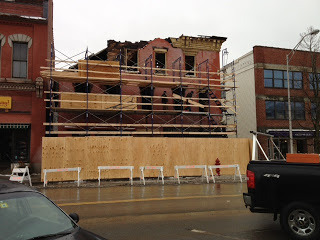
My novels often include structure fires in them (I've been there, done that -- my home burned in 1984). What intrigues me the most is the courage shown as people choose to rebuild lives, homes, and structures from the ashes. A high-five salute, then, to St. Johnsbury and to Bruno Ravel and the people pitching in -- on this gray late-January day, you point to what matters.
Today, though, with Bruno's savings and much assistance from state and local agencies, rebuilding of the structure is underway. Palmieri Roofing erected scaffolding, and at least four of the roofing company's workers were on site as I snapped this photo.

My novels often include structure fires in them (I've been there, done that -- my home burned in 1984). What intrigues me the most is the courage shown as people choose to rebuild lives, homes, and structures from the ashes. A high-five salute, then, to St. Johnsbury and to Bruno Ravel and the people pitching in -- on this gray late-January day, you point to what matters.
Published on January 30, 2013 09:40
December 12, 2012
More About the Chinese in Vermont, 1921
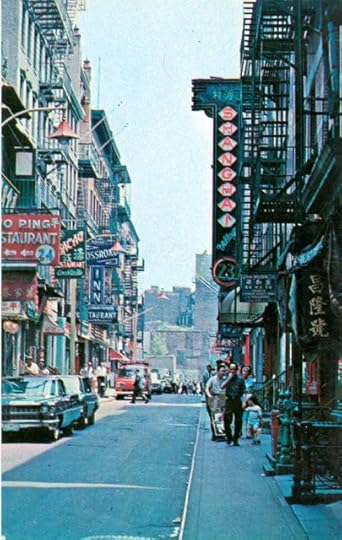 At Saturday's library event for COLD MIDNIGHT, I told the real (documented) story of Sam Wah, a man born in North China in 1846 who opened a laundry in St. Johnsbury, Vermont, in 1886 and lived here until his untimely death in 1921. Mr. Wah's murder was headline news for the town at the time, and ministers preached that the criminal must be captured -- there must be justice, for Mr. Wah was not "only a Chink" -- he was a Christian and part of the community.
At Saturday's library event for COLD MIDNIGHT, I told the real (documented) story of Sam Wah, a man born in North China in 1846 who opened a laundry in St. Johnsbury, Vermont, in 1886 and lived here until his untimely death in 1921. Mr. Wah's murder was headline news for the town at the time, and ministers preached that the criminal must be captured -- there must be justice, for Mr. Wah was not "only a Chink" -- he was a Christian and part of the community.Although that language may seem a bit forced to us now, there's no doubt that the town put its money down to seek justice. The town hired a famous detective, Jason Wood, from Boston, and the business community collected funds to purchase both a plot at the cemetery and a large, plain stone that says, "Sam Wah, Died December 27, 1921."
One of the attentive listeners on Saturday posed the question, "Did that mean there was very little racism in the town at that time?" Although I give full credit to what was done after Mr. Wah's death, and it's also well documented that the laundry owner socialized with the businessmen at the noon dinner in the local restaurant, as well as evening poker games -- I think it would be accurate to say there was an accepted form of racism in town that really hadn't particularly been thought through. Chinese were assumed to be a certain way, just as "Injuns" and black people were. Friendships across the lines of race were unusual, just as they also were often strained across the lines of religion and ethnic origin. (Irish Catholics and French Catholics had separate churches in the town until 1966.)
Moreover, the postcard shown here, with its colorful image as if one were traveling abroad, is of Chinatown in New York in the 1960s, and my husband Dave, who contributed it, transcribed the material typed on the back:
Chinatown-New York CityThe terms "curio shops" and "exotic foods" still (40+ years after Sam Wah's death!) carry that sense of the mystical "Orient." At a guess, from the postcards we've put together, as well as documents, people in 1921 -- even in "fair-minded Vermont" -- probably saw Asians as "exotic," "inscrutable," and even malicious. Hence the emphasis on "Christian like us" for Sam Wah.
[Dated on back Sept 13, 1968]
Looking East on Pell Street-ChinatownNew York City. A touch of the Orient is itsmost interesting feature. Here one will finda great variety of curio shops, restaurants,exotic foods, theatres, etc.
Interested in reading more about perceptions of Chinese in America in the late 1800s and early 1900s? Here are some informative websites, provided by Professor John Jung:
Chinese Laundries: Tickets to Survival on Gold MountainChopsticks in the Land of Cotton: Lives of Mississippi Delta Chinese GrocersSouthern Fried Rice: Life in a Chinese Laundry in the Deep SouthSweet and Sour: Life in Chinese Family RestaurantsChinese American Historian By Chance BlogI have another postcard to share, one from a couple of years after Sam Wah's murder; we're confirming some details in the historical research, and I look forward to sharing it with you soon.
Published on December 12, 2012 16:46
November 30, 2012
"Snow Day": Perfect for Writing!
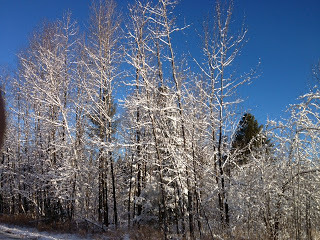 Last night's steady "flurries" gave us about four inches of snow by morning, and long before I got out in it, the deer had tracked all around the front and back yards, "pruning" the apple trees again. Darn! Well, I'll put up more fencing on Monday, after the weekend rain clears the ground.
Last night's steady "flurries" gave us about four inches of snow by morning, and long before I got out in it, the deer had tracked all around the front and back yards, "pruning" the apple trees again. Darn! Well, I'll put up more fencing on Monday, after the weekend rain clears the ground.Meanwhile, it was a perfect Snow Day. After routine morning chores (getting the papers for my husband, for example) and a happy-booted walk up on the ridge, I reached the desk, happy to escape to the three writing projects underway. Three!! Well, part of this past few weeks of silence has been spent in research and thinking, and I knew where each one was meant to go.
And now it's suppertime, but I've had a perfect writing session. PUNCH, the sequel to The Secret Room, is well underway, with chapter 1 expanded and ramped up to the tension that I wanted in it: http://www.wattpad.com/8080389-punch-a-vermont-mystery. (If you live in northern New England, you'll recognize the friction that "four wheelers" evoke in the community, as Shawna and Thea face the first day of school -- under circumstances that distress them both.)
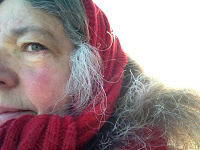 Second, the new book CHARLIE'S PLACE is off to a great start -- again, chapter 1, but this chapter reflects a 3-hour planning session with co-author Sue Tester, as well as 10 days of wrestling for the perfect words and images. I can't share that one yet, but I'm very, very excited about it.
Second, the new book CHARLIE'S PLACE is off to a great start -- again, chapter 1, but this chapter reflects a 3-hour planning session with co-author Sue Tester, as well as 10 days of wrestling for the perfect words and images. I can't share that one yet, but I'm very, very excited about it.Third is the new chapter -- chapter 28! -- of ALL THAT GLITTERS, a chapter that's confusing and stressful and part of the turning point of the book, as it's going to explode in two kinds of risky behavior within the next two chapters. Teen sleuth Felicity "Lucky" Franklin is in deeper than she knows ... thank goodness Michelle and Sandy are there with her. And a few other friends, too. Click here to start reading.
What's left for the day? Book reviews, of course! Watch the Kingdom Books review site this evening. I've got a lot to talk about -- and hope you'll join some of the conversations that these trigger.
PS -- EVENT COMING UP for COLD MIDNIGHT: Sat. Dec. 8, 10 a.m., at the Davies Memorial Library in Waterford, Vermont, I'll be talking about the Northeast Kingdom in 1921 and sharing photos and research that lie behind the unsolved "real" murder in the novel. Hope you can join us. If you can't, you can still order a signed copy at www.BethKanell.com (or pick up the book or e-books at local Vermont shops or online).
Published on November 30, 2012 13:59
November 18, 2012
From COLD MIDNIGHT, to American Anti-Chinese Expressions in the Late 1800s and Early 1900s
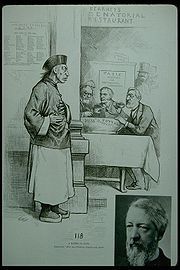 Thomas Nast cartoon of "John Confucius"St. Johnsbury, Vermont, had an unsolved murder in 1921 -- of a Chinese laundry owner named Sam Wah. Because the murder is at the center of my new YA mystery, COLD MIDNIGHT, I talk a lot at author events about the "historically real" murder and the way the local newspaper handled it at that time, as well as in later retrospectives.
Thomas Nast cartoon of "John Confucius"St. Johnsbury, Vermont, had an unsolved murder in 1921 -- of a Chinese laundry owner named Sam Wah. Because the murder is at the center of my new YA mystery, COLD MIDNIGHT, I talk a lot at author events about the "historically real" murder and the way the local newspaper handled it at that time, as well as in later retrospectives.One aspect raised a good question from a careful listener at Boxcar & Caboose, the town's welcoming bookshop.
"If Sam Wah was only hosting an 'endless' poker game for the local businessmen, why did the newspaper say he had a 'gambling den' instead?"
The sad answer is the anti-Chinese racism that thrived in America at that time.
Think back to the great era of building railroads across the nation -- most of them were done by the time of the Civil War. After the war was over, many Chinese men who had been kidnapped from their homeland to labor on the rails were suddenly out of work, and willing to take very low wages for other jobs. In the sluggish economic period that followed the war, this became an issue that we today recognize still: "Those Chinese are taking our jobs. Get rid of them! They're criminals and not like us, and besides, they are dirty!"
Those phrases come up in almost any form of racism or anti-group expression. In the late 1800s they led to federal legislation barring further Chinese entry into the country (except for "professionals" -- which included laundrymen!), forbidding Chinese women to arrive ("they would multiply like rabbits"), and saying Chinese could not become naturalized American citizens. The 1882 law actually broadened over the years, being used against all "Asians," until World War I sharply increased the need for males to go to war. Even without the law's force, though, the racism survived.
At that time, the term "Chinaman" was derogatory -- much like "Nigger." Cartoons created a persona of the ignorant, lazy, dirty, immoral Chinese, calling this figure "John Chinaman." Here's a short related piece particularly for educators (including relationships to state standards) that accompanies this image of "John Chinaman":
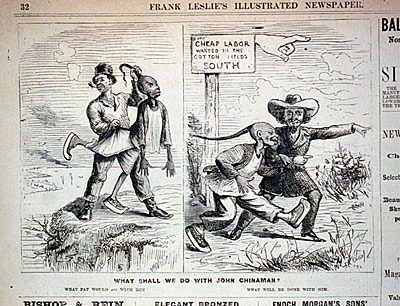
I thank my husband Dave for continued research on this, including the images that follow here:
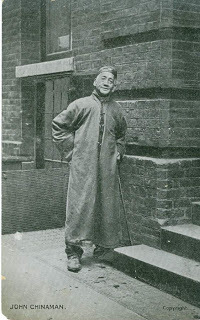 "John Chinaman" postcard
"John Chinaman" postcard
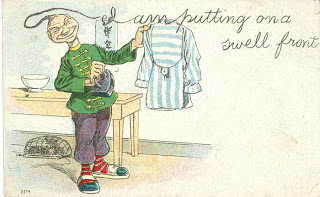 Dated on rear May 27, 1910, in Indiana.
Dated on rear May 27, 1910, in Indiana.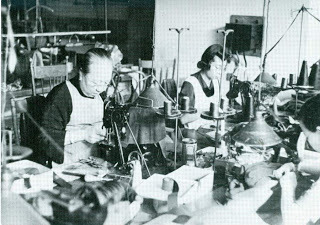 Chinese women finally arriving in the US after World War I -- part of a needed workforce.
Chinese women finally arriving in the US after World War I -- part of a needed workforce.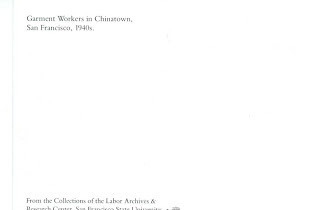
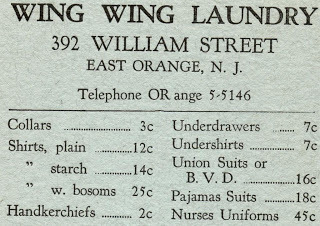 Chinese laundry prices, circa 1940
Chinese laundry prices, circa 1940A special note for those who appreciate exploring through music: American song lyrics also showed the feelings against Chinese at the time. See in particular "John Chinaman, My Jo," from Conner's Irish Songbook, 1868. And here is a link to the lyrics for "John Chinaman" and "The Heathen Chinee," from 1855 and 1870, respectively.
Published on November 18, 2012 10:12
November 3, 2012
One Book Arrives, One Book Being Written -- Mysteries!
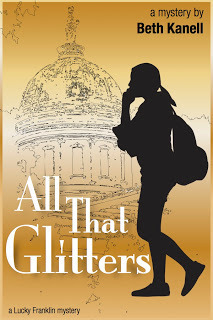 Although today is the Big Release Day for COLD MIDNIGHT, I'm also working on three (gulp) other books. Here's one of them: Late in the evenings, I write chapters of All That Glitters, the first of eight teen sleuth books featuring Felicity "Lucky" Franklin, in Montpelier, Vermont.
Although today is the Big Release Day for COLD MIDNIGHT, I'm also working on three (gulp) other books. Here's one of them: Late in the evenings, I write chapters of All That Glitters, the first of eight teen sleuth books featuring Felicity "Lucky" Franklin, in Montpelier, Vermont.You can watch the book being written -- read the chapters as their first drafts are posted! -- at WattPad. Click here to peek!
On November 5, this writing project gets featured on the blog of author and editor Penny Lockwood Ehrenkranz. Watch for a link to Penny's blog that morning!
Published on November 03, 2012 06:03
82 Years Ago, in St. Johnsbury, Vermont ...
 In the holiday season of 1921, local men who survived the terrible trench warfare of the Great War -- later known as World War I -- were home. But they hadn't been here long: Although the war ended in 1919, many soldiers remained in Europe for another year and a half, either taking part in "the peace" by choice or by orders, or detained in medical treatment. That means they came "home" in 1920 and 1921.
In the holiday season of 1921, local men who survived the terrible trench warfare of the Great War -- later known as World War I -- were home. But they hadn't been here long: Although the war ended in 1919, many soldiers remained in Europe for another year and a half, either taking part in "the peace" by choice or by orders, or detained in medical treatment. That means they came "home" in 1920 and 1921.Claire Benedict's father in COLD MIDNIGHT is one of these men, and as the autumn turns to winter in 1921, Claire is increasingly upset that her father, home for a few months, hasn't yet gone to work. Shell-shocked and coughing, her dad is not able to come through for Claire and her mom, the way Claire had imagined things would work out.
At the same time, a very different holiday season is unfolding for a man Claire doesn't even realize lives in her blue-collar Vermont town: a Chinese man who owns a laundry not far from the railroad station.
COLD MIDNIGHT -- which releases today, at stores in the Northeast Kingdom of Vermont (and Montpelier's Bear Pond Books), and also at www.BethKanell.com -- is a mystery and adventure novel that draws firmly on the real town of 1921 and a real murder that took place. I don't want to spoil the story by telling you too much now, but when you've read it, you'll find notes in the back of the book to make connections to what took place here.
Meanwhile, to get you in the mood, here is a real postcard, sent in 1921 as a holiday greeting, postmarked St. Johnsbury. It's a small world, so if you happen to know something about the sender, or the addressee, please do let me know!
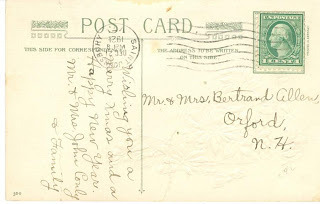 PS -- There are many more postcards and photos of the town here: http://pinterest.com/bethkanell/cold-midnight-climbing-on-roofs-at-night-solving-c
PS -- There are many more postcards and photos of the town here: http://pinterest.com/bethkanell/cold-midnight-climbing-on-roofs-at-night-solving-c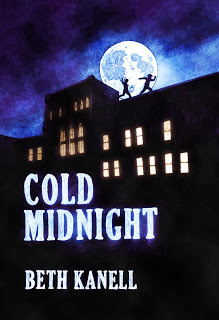
Published on November 03, 2012 05:55
October 6, 2012
Values and Writing: What's Your Stand?
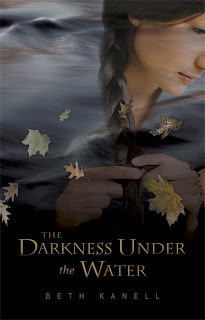 Around 2003, when I began writing THE DARKNESS UNDER THE WATER, I was well aware that outrage was one of the emotions driving me. I love Vermont so much that it's sometimes an ache inside me -- and reading (and copyediting) the nonfiction book Breeding Better Vermonters shocked me: People were verbally tormented, physically operated on (with the same motives as Hitler's), and made to suffer for generations, right here in my home state. Somebody needed to tell the story. And my way of "getting into" a story has often been through fiction. So, I decided to write a book from the point of view of a Vermont teen in 1930, coming to realize both the risk and the value of her Abenaki heritage.
Around 2003, when I began writing THE DARKNESS UNDER THE WATER, I was well aware that outrage was one of the emotions driving me. I love Vermont so much that it's sometimes an ache inside me -- and reading (and copyediting) the nonfiction book Breeding Better Vermonters shocked me: People were verbally tormented, physically operated on (with the same motives as Hitler's), and made to suffer for generations, right here in my home state. Somebody needed to tell the story. And my way of "getting into" a story has often been through fiction. So, I decided to write a book from the point of view of a Vermont teen in 1930, coming to realize both the risk and the value of her Abenaki heritage.With THE SECRET ROOM, I wrestled with some other areas where I thought things could be made more fair: in the way the history of the Underground Railroad is reported in northern New England, and in the important area of girls and math, an area dear to me because I've always been "good" in math and science, and in fact took a college degree in chemistry (there were two of us "girls" among the eight chemistry majors in our senior year at Michigan State University in 1969).
Now it's almost time for COLD MIDNIGHT to be published (the eBook is already available; the printed book comes out November 3). And again, I've pinned to a part of history (underneath the murder-mystery plot) that involves two issues that matter to me: the injustice of America's first federal legislation that discriminated against an ethnic group -- the Chinese Exclusion Act of 1882 -- and the class structure that can make things rough for kids from working-class families.
My own family, when I was growing up, lived in a house about three-fourths down the slope of the mountain that defined social status in Montclair, New Jersey. My dad moved into management during those years, but for a manufacturing firm where he still dealt with blueprints and machines. Neither of my parents knew much about four-year colleges, and I was the first in the family to complete a bachelor's degree. Saturdays were for yard work and housecleaning, not for "cultural enrichment," although sometimes Saturday afternoons could include a visit with our family friends the Buffingtons, where the dad was a teacher and the mom, like mine, mostly stayed at home until the kids were in high school.
In the past few years, I've come to understand something else about my family that probably helped create the way that I approach writing a novel: My grandfather Ernest, born a Jew in Germany in 1898, told me when I was about 12 years old that the most important value in the world is "Tolerance." He spoke from his observation of World War II, the concentration camps, survival of families, and much more. And on my mom's side of the family, the Quaker stance of my mother's mother's family was my mom's great source of pride, because she knew it involved taking a stand for justice when injustice flourished. Here are scans from a letter that my grandfather sent home to his two small sons, as he traveled in Egypt in the 1930s, probably on business:
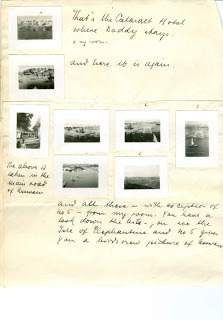
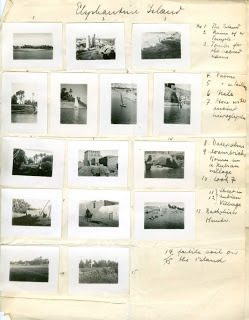
What are your values? How do they affect what you write, what you read, who you share books with? Share a few sentences here; I'm interested.
Published on October 06, 2012 11:11
October 4, 2012
COLD MIDNIGHT: Early Bird Access to the eBook
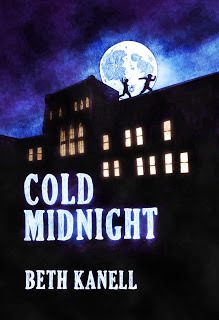 Amazon and my fabulous publisher, Raphel Publishing, just made it possible for readers in a rush to download the eBook of COLD MIDNIGHT, a month before the printed book will release (Nov. 3). Got your Kindle, iPad, or other reading device warmed up and ready? Let me know what you think of the book! Here's the link for COLD MIDNIGHT in e-form. Have fun!
Amazon and my fabulous publisher, Raphel Publishing, just made it possible for readers in a rush to download the eBook of COLD MIDNIGHT, a month before the printed book will release (Nov. 3). Got your Kindle, iPad, or other reading device warmed up and ready? Let me know what you think of the book! Here's the link for COLD MIDNIGHT in e-form. Have fun!
Published on October 04, 2012 16:29
Setting a New Novel: Getting to Know Montpelier, Vermont (Better)
<!-- /* Font Definitions */ @font-face {font-family:"MS 明朝"; mso-font-charset:78; mso-generic-font-family:auto; mso-font-pitch:variable; mso-font-signature:1 134676480 16 0 131072 0;} @font-face {font-family:"MS 明朝"; mso-font-charset:78; mso-generic-font-family:auto; mso-font-pitch:variable; mso-font-signature:1 134676480 16 0 131072 0;} /* Style Definitions */ p.MsoNormal, li.MsoNormal, div.MsoNormal {mso-style-unhide:no; mso-style-qformat:yes; mso-style-parent:""; margin:0in; margin-bottom:.0001pt; mso-pagination:widow-orphan; font-size:12.0pt; font-family:"Times New Roman"; mso-fareast-font-family:"MS 明朝"; mso-fareast-theme-font:minor-fareast;} .MsoChpDefault {mso-style-type:export-only; mso-default-props:yes; font-size:10.0pt; mso-ansi-font-size:10.0pt; mso-bidi-font-size:10.0pt; mso-fareast-font-family:"MS 明朝"; mso-fareast-theme-font:minor-fareast; mso-fareast-language:JA;} @page WordSection1 {size:8.5in 11.0in; margin:1.0in 1.25in 1.0in 1.25in; mso-header-margin:.5in; mso-footer-margin:.5in; mso-paper-source:0;} div.WordSection1 {page:WordSection1;} </style> <br />"The Sleuth of Montpelier, Vermont"<br /><div class="MsoNormal"><br /></div><div class="MsoNormal">A Writer's Research Adventure</div><div class="MsoNormal"><br /></div><div class="MsoNormal"><div class="separator" style="clear: both; text-align: center;"><a href="http://4.bp.blogspot.com/-X2AP85UNe0c..." imageanchor="1" style="clear: right; float: right; margin-bottom: 1em; margin-left: 1em;"><img border="0" height="320" src="http://4.bp.blogspot.com/-X2AP85UNe0c..." width="240" /></a></div>In a little “study” under the stairs, my father labored with ruler and Number 4 pencil on a single sheet of blued paper on which he could make scaled drawings. Nearby, curled in an armchair, the 10-year-old “me” read her Nancy Drew books, and understood that the secret panels and hidden rooms within the mysteries began their lives with someone else’s version of Dad’s blue pages.</div><div class="MsoNormal"><br /></div><div class="MsoNormal">There were trap doors, like the one in the floor of the wardrobe in “The Secret of the Wooden Lady,” which also included two cleverly crafted panels that Nancy discovered with her careful fingers; in “The Sign of the Twisted Candles,” the girl sleuth examines a camouflaged back stairway, then with her boyfriend Ned begins a hunt for the dead homeowner’s treasures: “Every panel in the ceilings, walls, and floorboards was carefully examined. … Ned cried out, ‘Nancy! Come here! I think I’ve found something!” She ran to his side in the rear hall. ‘Look! The grasss cloth on this wall is a little different from the rest and a twisted candle has been worked into the design.’” There’s a safe hidden behind the significant design element.</div><div class="MsoNormal"><br /></div><div class="MsoNormal">Now that I’m writing a “Vermont Nancy Drew” series set in Montpelier, I’ve tuned in to the wide range of design trends that resulted in the many-aged downtown architecture of Vermont’s capital. If I want my sleuth, Felicity “Lucky” Franklin, to discover a hidden room or secret panel, what structure will she explore? In this case, it has to be (for plot reasons) both the State House and the Blanchard Opera Block, now home to the bookstore that belongs to Lucky’s mom (the real store owner is collaborating) and once host to grand performances in the early 1900s, including the arrival of young elephants with the touring circus!</div><div class="MsoNormal"><br /></div><div class="MsoNormal">A behind-the-scenes exploration of the State House with ardent conservation curator David Schütz convinced me that the structure’s major idiosyncrasies lie in its dome, which sits atop the legislative “box” but is a unit unto itself. “My” sleuth will find clues there, among the oddly positioned timbers and scrawled graffiti. In the Blanchard Opera House, though, she’ll discover an actual hiding place.</div><div class="MsoNormal"><br /></div><div class="MsoNormal"><a href="http://3.bp.blogspot.com/-BRMxfyYdvy4..." imageanchor="1" style="clear: right; float: right; margin-bottom: 1em; margin-left: 1em;"><img border="0" height="240" src="http://3.bp.blogspot.com/-BRMxfyYdvy4..." width="320" /></a>Could Montpelier architect and sometime mayor George Guernsey, who designed the Blanchard Opera House, actually have ensured a concealed area in the building? Norwich University student Megan Morse and Putney preservation pro Lyssa Papazian tracked Guernsey’s work and life (1839-1900) in detail. The era fits that of Lambert Packard, St. Johnsbury’s major architect (1832-1906), and at least one of Packard’s buildings has a hidden panel next to a fireplace. Guernsey himself favored intricacy and Italianate detail. Although none of his documented structures in Montpelier show false walls, hidden doors, or secret panels, the grace of fiction allows me to insert one with a relative amount of believability.</div><div class="MsoNormal"><br /></div><div class="MsoNormal">But that’s not quite enough for the kind of fiction I’m writing, which always hinges on some aspect of Vermont history, as well as a puzzle rooted in the life stages of teenagers. So I have two more components of Guernsey’s real life to weave in: his local nickname of “King George,” and his death of tuberculosis. </div><div class="MsoNormal"><br /></div><span style="font-family: "Times New Roman"; font-size: 12.0pt; mso-ansi-language: EN-US; mso-bidi-language: AR-SA; mso-fareast-font-family: "MS 明朝"; mso-fareast-language: EN-US; mso-fareast-theme-font: minor-fareast;">In the process of crafting these mysteries (the first of is “All That Glitters”), I hope to also bring attention to George Guernsey himself and to his structures, which probably number in the hundreds, whether churches, houses, commercial blocks, or public buildings like libraries and schools. A little extra knowledge may yet make the difference in a decision to maintain a George Guernsey building at a valued town or city location – whether there is a secret panel in it, or not.</span><br /><br /><span style="font-family: "Times New Roman"; font-size: 12.0pt; mso-ansi-language: EN-US; mso-bidi-language: AR-SA; mso-fareast-font-family: "MS 明朝"; mso-fareast-language: EN-US; mso-fareast-theme-font: minor-fareast;">[Photos of details of a George Guernsey building, the Edward Dewey house, courtesy of Don Shall.] </span> <div class="blogger-post-footer"><img width='1' height='1' src='https://blogger.googleusercontent.com...' alt='' /></div>
Published on October 04, 2012 16:23



